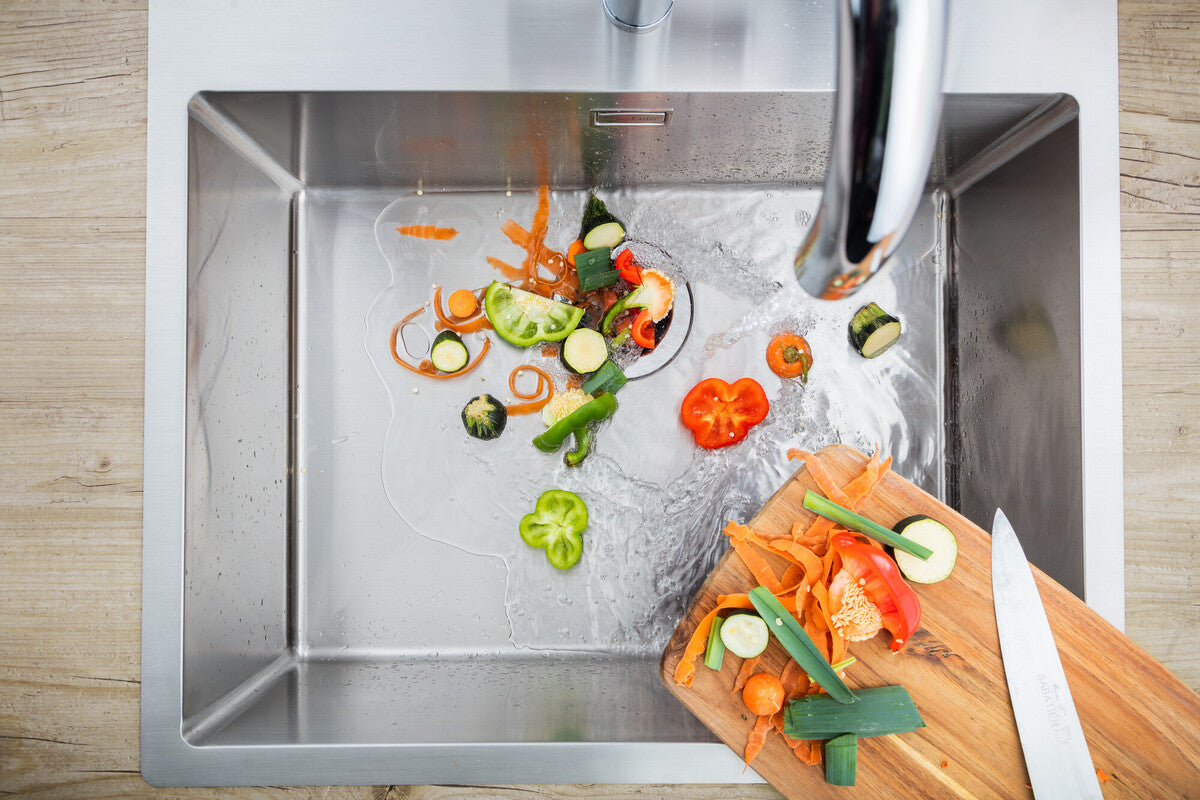
Why waste disposals are saving the world
|
|
Time to read 6 min
Written by: Taps UK
|
Published on
|
Time to read 6 min
In the UK, around 9.5 million tonnes of food waste is thrown away every year. Globally, nearly a third of all food produced ends up wasted. Much of this goes to landfill, where it produces harmful greenhouse gases such as methane.
A waste disposal unit offers a cleaner and more sustainable alternative. Fitted neatly under your sink, the unit grinds food waste into fine particles. When you run the tap, these particles are flushed into the drainage system and processed at your local wastewater treatment plant. In many areas, this waste is then used to create renewable energy and fertilisers, making it far more environmentally friendly than landfill.
Waste disposal units also improve kitchen hygiene. You avoid the unpleasant smell of rotting food waste sitting in a bin, especially during the warmer months.
Instead of filling your kitchen bin with scraps, a food waste disposal unit lets you deal with waste instantly and hygienically. They are compact, easy to install under most sinks, and simple to operate.
If you’re considering one for your home, here are the main pros and cons of waste disposal units:
A waste disposal unit is an appliance installed under the kitchen sink that grinds food scraps into fine particles. These are then flushed through your plumbing system with water, helping to reduce food waste going to landfill.
You can safely put most food scraps, such as fruit and vegetable peelings, small bones, cooked leftovers, and coffee grounds. Avoid fibrous foods, grease, oil, and non-food waste, as these can cause blockages or damage.
No, not if they are maintained properly. Running cold water while in use, flushing with mild detergent, or grinding lemon peels helps keep the unit clean and prevents odours from building up.
Used correctly, a waste disposal unit will not block pipes. Problems usually occur if grease, oil, fibrous foods, or large quantities of waste are put inside. Always run plenty of cold water to keep the system clear.
Eco-friendly food waste management – diverts waste away from landfill, reducing methane emissions and supporting renewable energy production.
Improved kitchen hygiene – no rotting food in the bin, fewer odours, and less risk of attracting pests.
Convenience – instantly dispose of scraps such as vegetable peelings, fruit cores and plate leftovers without filling your kitchen bin.
Space-saving – reduces the need for multiple kitchen bins or frequent emptying.
Cost-effective in the long run – can cut down on bin bags and food waste collection charges in some UK areas.
Compatible with most sinks – modern waste disposal units are compact and designed to fit easily beneath standard kitchen sinks.
Simple operation – one-button or switch control with water flow makes them user-friendly for all households.
Initial cost – purchasing and installing a unit can be more expensive than using standard bins.
Running costs – they use electricity and water, although consumption is typically low.
Not suitable for all waste – bones, fibrous vegetables (like celery), and large amounts of oil or fat should not be put into the unit.
Noise levels – although many modern units are designed to be quieter, some models can still be loud during operation.
Maintenance – occasional cleaning is needed to prevent build-up and odours.
Plumbing limitations – older homes or properties with outdated pipework may require additional plumbing work.
Instead of carrying plates back and forth between the kitchen table, sink and bin, a waste disposal unit lets you scrape leftovers straight into the sink. This makes clearing up after meals faster and more convenient – exactly what you want at the end of a long day. It also reduces how often you need to empty your kitchen bin, as most food scraps can be processed instantly.
Modern food waste disposers can handle a wide range of items. Once inside the unit, the food is ground into fine particles and flushed away with water in seconds.
Common types of food waste suitable for disposal units include:
Vegetables – peelings, offcuts and cooked leftovers
Fruit – cores, rinds and skins
Eggshells – easily broken down into fine particles
Bones from fish and poultry – small, soft bones can be processed safely
Meat scraps – small pieces of cooked or raw meat
Fish waste – skin, heads and small bones
It’s easy to get into the habit of leaving plates in the sink without scraping them properly. The problem is that leftover scraps can build up in your pipes, leading to blockages, unpleasant odours, and even costly plumbing repairs.
A waste disposal unit solves this issue by grinding food waste into fine particles that are safely flushed away with water. This makes it far less likely for food to get stuck in your pipes and helps keep your kitchen plumbing running smoothly.
Tips to Keep Your Waste Disposal and Pipes Clear:
Run cold water before, during, and after using the unit to help flush particles through the pipes.
Avoid pouring fats, oils, and grease into the disposal, as these can solidify and cause blockages.
Use citrus peels or baking soda occasionally to keep the unit clean and smelling fresh.
Don’t overload the unit – feed waste gradually for smoother operation.
Avoid fibrous foods like corn husks or celery, which can tangle the blades.
A waste disposal unit, often called a food waste disposer, is a compact appliance that fits neatly under your kitchen sink. Its purpose is simple: to grind leftover food into fine particles so it can be safely flushed away with water.
The process is straightforward:
Scrape food into the sink – vegetable peelings, fruit scraps, small bones, and leftovers can go directly into the unit.
Activate the unit – depending on the model, this may be a wall switch, an air switch on the worktop, or an automatic sensor.
Grinding chamber at work – inside the unit, a fast-spinning plate with blunt impellers forces the food against a grind ring. Instead of cutting, it pulverises scraps into tiny particles.
Flush with water – once ground, cold water from the tap washes the particles through your pipes into the local wastewater system.
Treatment and energy recovery – at the treatment plant, food waste can be converted into biogas for renewable energy or used as fertiliser, making the process far more sustainable than landfill.
Modern waste disposal units are safe, hygienic, and easy to use. They don’t have sharp blades, so there’s no risk of cutting yourself. They also help reduce bad odours in your kitchen by keeping food scraps out of the bin.
By turning everyday waste into something that can be processed for energy, a waste disposal unit is a practical, eco-friendly upgrade for any kitchen.
This article explains how waste disposal units can transform how UK homes handle food waste. It covers how the units work, their eco benefits—like reducing methane from landfills and supporting renewable energy—plus key pros and cons. You’ll learn how they simplify kitchen cleanup, protect your pipes, and what types of waste they accept. Finally, it guides you with tips to keep your unit efficient and your drains clear.
How they work: Waste disposal units grind food scraps into fine particles and flush them with water to your wastewater system, where they can be turned into renewable energy or fertiliser.
Benefits: These units improve kitchen hygiene, reduce landfill waste, save bin space, and can lower bin bag costs in some UK areas.
Cons to consider: They involve upfront investment, use electricity and water, aren’t ideal for fibrous or fatty waste, may produce noise, and could require plumbing updates in older homes.
Maintenance tips: Run cold water during use, avoid grease and fibrous scraps, clean with citrus peels or baking soda, and feed the unit gradually to keep it running smoothly.
Taps UK is a prominent online retailer in the United Kingdom, specializing in a wide variety of kitchen and bathroom products. The company boasts a large selection of taps, sinks, and accessories from both well-known industry brands and its own exclusive lines, catering to a broad customer base that includes the general public as well as trade professionals like developers and builders.
Email Us: hello@tapsuk.com
Call Us: 01527 868500
Get all the latests news and offers from our team right to your inbox
Accepted payment methods:
© 2025 TAPS UK . All Rights Reserved.






